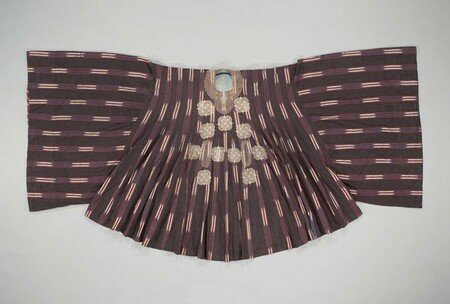"Resisting Color: Textiles Tied and Dyed" au Dallas Museum of Art
Coat (chapan) Uzbekistan Early 20th century, Silk and cotton; coat: warp-faced plain weave with warp ikat (silk); lining: cotton fabric. Overall L 51 in. x W (at sleeves) 56 3/4 in. (129.54 x 144.145 cm)Dallas Museum of Art, gift of Sally R. and William C. Estes
DALLAS, TX.- The Dallas Museum of Art presents an exhibition featuring international textiles ranging in date from the late 19th to the middle of the 20th century, half of which are recent additions to the DMA’s permanent collection and will be shown for the first time.
Resisting Color: Textiles Tied and Dyed, organized by Carol Robbins, The Ellen and Harry S. Parker III Curator of the Arts of the Americas and the Pacific, and on view beginning April 27 in the Museum’s Focus Gallery I, features 18 textiles. They are international in origin, representing Argentina, Chile, Ecuador, and Guatemala in the Americas; Côte d’Ivoire, Cameroon, and Algeria in Africa; and Indonesia (the islands of Bali, Sulawesi, Sumba, and Flores), Laos, China’s Hainan Island, and Uzbekistan in Island Southeast Asia and mainland Asia. Most of the textiles in the exhibition were originally used as ceremonial clothing, but several examples functioned on their own in ritual events.
The exhibition’s title, Resisting Color: Textiles Tied and Dyed, refers to the techniques by which the designs on these textiles were created. The patterning on each textile in the show resulted from a process that resisted the coloring agent or dye. For some, such as the Hausa man’s robe from Cameroon in West Africa and the Mapuche poncho from Southern Chile, the yarns were tied and dyed before they were put on the loom and woven (ikat). For others, including the Ranquel chief’s poncho from Argentina, woven cloth was tied before it was dyed (plangi). These two ponchos representing both the ikat and plangi techniques have never before been presented together in the United States.
Resisting color does not mean an absence of color. Even when the process is restricted to two colors—dark blue and white are common—the variation in the blue can be remarkably nuanced. Additional colors can be added by repeating the tying and dyeing process.
“The exhibition began as a way to showcase recent additions to the Museum’s textile collection and attest to the cultural diversity of the collection overall,” said Robbins. “However, it quickly transformed into a tribute to the dyers’ art, which is itself rich in aesthetic and cultural significance.”
Man’s robe, Cameroon : Hausa people, 20th century Cotton; warp-faced plain weave with warp stripes, warp ikat, and embroidery. L 50 x W107 in. (127 x 2 m 71.781 cm) Dallas Museum of Art, Textile Purchase Fund

/https%3A%2F%2Fprofilepics.canalblog.com%2Fprofilepics%2F1%2F0%2F100183.jpg)
/https%3A%2F%2Fstorage.canalblog.com%2F03%2F02%2F119589%2F96711876_o.jpg)
/https%3A%2F%2Fstorage.canalblog.com%2F11%2F31%2F119589%2F94773502_o.jpg)
/https%3A%2F%2Fstorage.canalblog.com%2F20%2F83%2F119589%2F94772815_o.jpg)
/https%3A%2F%2Fstorage.canalblog.com%2F26%2F72%2F119589%2F75604929_o.jpg)
/https%3A%2F%2Fstorage.canalblog.com%2F59%2F60%2F119589%2F26458628_o.jpg)




/image%2F1371349%2F20240429%2Fob_a32180_438086347-1659660838137262-66806538687.jpg)
/image%2F1371349%2F20240429%2Fob_5853a1_440937185-1660184551418224-14760604465.jpg)
/image%2F1371349%2F20240428%2Fob_096a92_telechargement-10.jpg)
/image%2F1371349%2F20240428%2Fob_d84f93_telechargement-8.jpg)